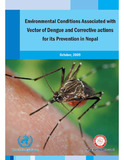Please use this identifier to cite or link to this item:
https://hdl.handle.net/20.500.14356/788Full metadata record
| DC Field | Value | Language |
|---|---|---|
| dc.contributor.author | Nepal Health Research Council (NHRC) | - |
| dc.date.accessioned | 2012-12-28T22:13:25Z | - |
| dc.date.accessioned | 2022-11-08T10:20:40Z | - |
| dc.date.available | 2012-12-28T22:13:25Z | - |
| dc.date.available | 2022-11-08T10:20:40Z | - |
| dc.date.issued | 2009 | - |
| dc.identifier.uri | http://103.69.126.140:8080/handle/20.500.14356/788 | - |
| dc.description.abstract | Introduction: Dengue is a climate sensitive vector borne diseases, which in recent years has become a public health concern. Dengue is transmitting in tropical and sub-tropical regions around the world, predominantly in urban and suburban areas (WHO Fact Sheet 2006). Domestic Dengue virus(DV) infection occurs in more than 100 countries and over 2.5 billion people live in the areas with a risk of dengue virus infection( WHO,1999,2002). Up to 100 million cases of Dengue fever( DF) and 500,000 cases of Dengue Hemorrhagic Fever (DHF) and several thousands deaths are estimated to occur annually worldwide (WHO). During the past decades, dengue virus emerged in South Asia and DF/DHF epidemics occurred in Bhutan, India, Maldives, Bangladesh and Pakistan (WHO, 2007). The global prevalence of dengue has grown dramatically in the recent decades. | en_US |
| dc.language.iso | en_US | en_US |
| dc.publisher | Nepal Health Research Council | en_US |
| dc.subject | Dengue | en_US |
| dc.subject | Nepal | en_US |
| dc.title | Environmental conditions associated with vector of dengue and corrective actions for its prevention in Nepal | en_US |
| dc.type | Technical Report | en_US |
| Appears in Collections: | NHRC Research Report | |
Items in DSpace are protected by copyright, with all rights reserved, unless otherwise indicated.

